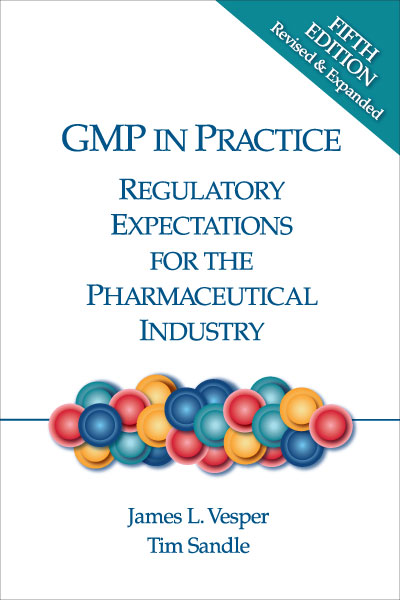Hot Read: GMP in Practice

July, the fifth edition of the PDA/DHI book, GMP in Practice: Regulatory Expectations for the Pharmaceutical Industry was published. The PDA Letter interviewed authors Tim Sandle and James Vesper about this bestselling book, which can be purchased in the PDA Bookstore.
PDA Letter: Why do you think this book has consistently been a bestseller?
Sandle: There is nothing else out there that reviews the major GMPs in this way—breaking GMPs down into the most important areas, and then comparing the various clauses. This makes the book a must for those who are regularly inspected by more than one agency or wish to operate in different regions. Without this book, the task anyone must face in meeting these challenges is enormous.
Vesper: I suspect there are a couple of reasons. First, in many cases the GMPs are not all that specific—they give the “what” and sometimes a high-level “how.” For example, U.S. GMPs, say “adequate space... to prevent mix-ups” (211.42(b)), but what does that really mean? By using different requirements from Canada, the European Union, WHO and ICH, we can get a richer understanding of what inspectors expect to see. Second, with globalization, we in the industry need to have a certain amount of harmonization to meet all applicable requirements. Companies have been doing that harmonization internally. This book is aimed at helping with that.
PDA Letter: What is different about this edition?
Sandle: The main difference is that all the GMPs have been updated. There have been some changes to U.S. GMPs due to new U.S. FDA guidances, a vast number of European GMP chapters have been rewritten and Canadian regulations have been completely revamped. In addition, the major regulatory agencies have adopted the ICH quality guidelines.
Putting all this together, it is clear that the scope of GMP continues to grow. This can be seen with GDP, which has become far more detailed in relation to the supply chain and with data integrity. Each major regulatory agency has issued guidance for the latter. A further change since the last edition has been the expansion in single- use, disposable technology, which brings with it areas to consider like leachables, extractables and methods of sterilization.
The book also highlights the potential applicability of Annex 1 to nonsterile manufacturing, and there are elements here that can be applied, such as personnel controls, disinfection and training.
Vesper: I suspect there are a couple of reasons. The EU GMPs have been updated since the 4th edition came out in 2011, so this new edition reflects these changes. We were all ready to send the manuscript to the printer when the Canadians finalized their revised GMPs that take effect in October of this year, so we went back and revised/updated those references. Because of the global concern for data quality and data integrity, we thought that deserved a dedicated chapter. Annex 1 was not finalized when we were writing this; we had to rely on the draft issued in December 2017. We looked at the draft requirements more from a conceptual standpoint.
PDA Letter: What are some of the common expectations that you have seen for elements included in a pharmaceutical quality system?
Sandle: The big push across the GMPs with pharmaceutical quality systems lies in the need for a holistic strategy, in that each of the various elements required for a robust quality system needs to be joined together into a coherent whole. Structuring an internal company document around the different chapters in this book would provide a useful framework for companies that lack such a document. This is also important because a company’s pharmaceutical quality system will be evaluated during an inspection, and it plays an important role in the new drug product submission process.
Vesper: Some of the “themes” or common threads that I see running through the pharmaceutical quality system include not just risk management but risk-based thinking. To me, this means not just doing formal risk assessments but viewing all that we do in terms of understanding risks and taking appropriate actions to reduce those risks that we know to be significant. Also, looking at trends—what are the data telling us and how should we respond? Management support is a third theme— understanding what the issues really are and taking proactive steps to resolve them.
PDA Letter: Does this book address new technologies and processes, such as parametric release?
Sandle: The book contains all of the guidance on parametric release, which is linked to the chapter on terminal sterilization. We recognize that parametric release is of interest to a number of firms, in terms of saving time on batch releases and with resources. There are other benefits as well, like manufacturing flexibility (moving product to market more rapidly where there are drug shortages), gaining better process understanding and strengthening manufacturing controls.
Parametric release also features in the parts of the book applicable to nonsterile manufacturing, such as the use of scientifically sound in- process controls and chemical measurements.
PDA Letter: Who would be best served by reading this book?
Sandle: The audience is anyone involved with pharmaceuticals and healthcare products, for there is no area untouched by GMP—from purchasing to distribution of medicines. The substantive sections of the book, which are about manufacturing, laboratory testing and release, will appeal to quality assurance, quality control, validation, manufacturing and inspection departments. This enables companies to benchmark their practices.
The book is also useful when preparing for international inspections, especially if the company is unfamiliar with the regulators who will be conducting the audit. So, those in the United States who are unfamiliar with inspectorates following EMA GMPs can get a feel for what is required and, likewise, will those in Europe can better prepare for a U.S. FDA inspection.
Vesper: From what people have told us about previous editions, it has been used as a reference by those in quality assurance and also technical/manufacturing operations. One quality assurance person said it was valuable to have expectations covering a certain topic pulled together in one reference. Another firm used it to train supervisors, asking them how GMP expectations were realized in their operations and what needed to be improved.
It will also help readers have much more fascinating conversations at dinner parties.
About the Experts
Tim Sandle, PhD, is a pharmaceutical microbiologist with 25 years of experience working in the pharmaceutical and healthcare sectors.
James Vesper, PhD, has worked in the pharma/biopharma industry for more than 35 years, starting out at Eli Lilly and Company where his last role was leading the GMP Training and Education group.


